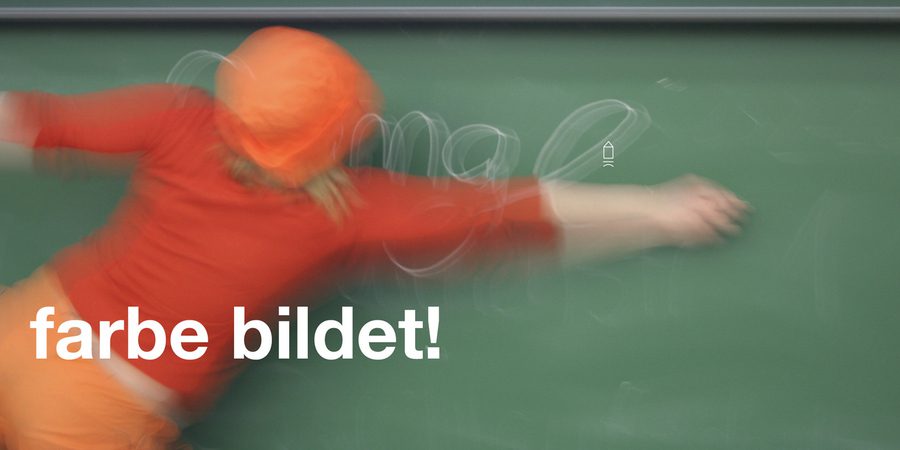COLOR CREATES AWARENESS
It is only through the all-round activity of the mind, imagination and sensory perception that each person develops an awareness of their individual possibilities to help shape their own existence in the socio-cultural environment. The holistic approach of the educational concept dating back to Alexander von Humboldt is supported today by current findings from neuropsychologically based learning research. This gives the process of awareness-raising a central position in scientific educational discourse and pedagogical practice. Attention and interest are the prerequisites for conscious perceptions, sensations, memories and mental considerations, as well as for evaluations, planning and concepts. The concept of consciousness is not an abstract one, as it can only be described through concrete content, which gives our most important sensory medium, color, a central position.
COLOR CREATES MOTIVATION FOR ACTION AND BEHAVIOR
Colors appear to us atmospherically dissolved or physically materialized. Their formal properties can be described systemically via attributes such as brightness, colorfulness, intensity, saturation, temperature, transparency and many more, while their content-related properties are regulated via the character reference. According to this, colors shape our expectations of the materiality, taste, smell, sound and behavior of things, whose intentionality describes our scope of action. Once we have developed a basic idea of our living world from the interplay of the senses, the mind and our feelings, we can no longer refrain from viewing the dynamic color configurations before our eyes or within our imagination as carriers of action. Colors are gestures wherever they refer to behavioral states. It is not the color itself, but the color changes that form the starting point of our interpretations, on the basis of which we form a functioning memory representation of our own existence in the environment.
COLOR FORMS ORIENTATION
Current research findings in neuropsychology show that humans receive around 80% of all information via the sensory medium of color, around 60% of which is processed by the brain. As soon as we open our eyes, we are in a constant exchange of information with our environment via 250 million photoreceptors. Not even 10% of them can convert the spectrum of light into color signals, but these are concentrated in the foveal center of the retina, through which we control our eye movements. Like the tip of a finger, we move the fovea over colored areas and their borders and draw letters, shapes and spaces from them, the changes of which we experience as movement. Color creates orientation and thereby controls our attention as well as our interest in the inexhaustible information potential of the environment to which light gives us access. Colors form the information medium for the interpretations from which each individual creates a dynamic picture of their reality.
COLOR FORMS LANGUAGE
While spoken language in all its forms has long been at the center of educational discourse, the conference will focus on the non-verbal realm of interpersonal communication, in which the phenomenon of color plays a key role. It is not spoken language that determines the form of human experience and knowledge, but the sensually perceptible and recognizable content. Without a vivid background of experience, words remain empty and incoherent. The visible part of the environment is completely filled with colors, whose meaning background and linking structure represent the most powerful experience matrix as well as the greatest “knowledge potential” of humans. This fact alone provides both an opportunity and a challenge for a discussion and re-evaluation of the phenomenon of color in the current educational discourse, aimed at orientation, knowledge and understanding. Like no other sensory medium, color determines our experiential knowledge and, by extension, the meaning structure of word language. Concepts without views are empty.
COLOR CREATES IDENTITY
Every sighted person explores the cognitive potential of color in everyday life when they first open their eyes. Even before language acquisition, the toddler begins to construct his own ideas about the reality of life, which is represented to him in the colors of his surroundings. The vivid experiences from the process of multi-sensory confrontation with the living environment shape spatial concepts, the ability to orient oneself and one’s own identity, which are subsequently expanded and updated throughout life. At all times, we only see the result of our interpretations, which is why the further development of our view of the world and our personality requires a lifelong educational process. Color is a global medium of communication through which the characteristics and commonalities of all cultures become visible and recognizable. Color allows us to engage in non-verbal exchange and to shape ideas. Color connects.
COLOR FORMS BRIDGES
The culture of color combines science and art, as the medium can be viewed as a wavelength, energy frequency, information potential or design material, depending on the perspective. Color is the basic material of empirical observation and the visual arts. Color originates in the brain and also exists outside of human consciousness as a form of visualization of our natural and socio-cultural world. Color represents the vivid memory of mankind and combines aesthetics and function. Color makes the inner world of thoughts and emotions visible to us and others and thus forms the most important non-verbal basis of interpersonal communication. We therefore use color in all areas of society and apply it as required to identify processes, solve problems and communicate content.
CONSEQUENCE
The central question of the conference is therefore how we can harness the potential of color for understanding, insight, problem-solving and mediation for the holistic education of the human individual in every phase of their developmental process.
- Publication in Phenomenon Color, ISBN 978-3-00-036547-8
- Schrödel art portal, creative card index
- [download id=”19″ format=”2″]
- Color Forms… (English publication of the article)
- Link to the Magazine and download article +report+ Chemistry and related sciences



